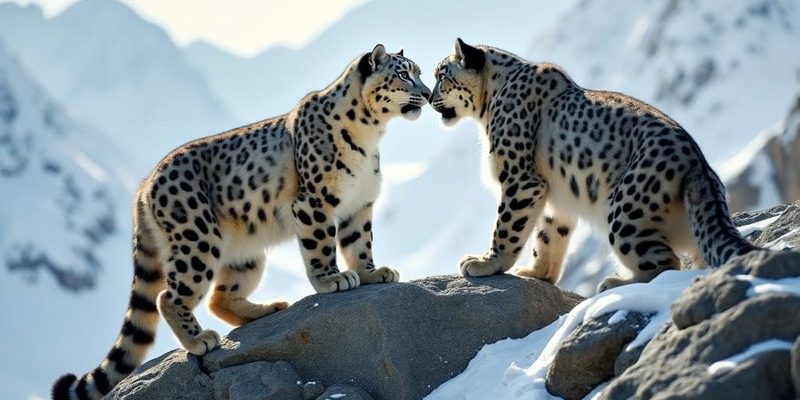
Imagine being a parent in a remote, rugged environment with predators lurking nearby and limited resources. Snow leopards are experts in this terrain, and they go to great lengths to ensure their young survive. Let’s take a closer look at how these magnificent felines care for their offspring in the wild.
The Mating Process and Cub Birth
Snow leopards typically mate between January and March. The male and female track each other’s scent marks, which leads to a complex courtship dance. It’s a bit like dating, where they’ll engage in playful antics and vocalizations to bond. Once they’ve paired up, the female will find a hidden nursery site—often in rocky crevices or caves—to give birth.
After a gestation period of around 90-100 days, a new mother will usually deliver between two to four cubs. This is a critical time, as the cubs are born blind and utterly dependent on their mother. Snow leopards are solitary animals, so it’s up to the female to provide all the care and protection for her little ones.
First Days and Weeks of Life
In those early days, you might picture the cubs huddled together for warmth, relying on their mother’s nurturing instincts. She stays in close proximity, keeping her cubs safe from potential threats while they grow stronger. Honestly, it’s a tough gig when you think about it! The mother has to remain vigilant, constantly scanning the environment for dangers like wolves or even other big cats.
During this time, the cubs will start to open their eyes and slowly begin to explore their surroundings. Their mother will often move them to new locations to keep them hidden from any watchful eyes. Just like a parent might baby-proof a nursery, the mother snow leopard creates a safe haven for her young.
Feeding and Growth
Feeding cubs is another vital task for snow leopard mothers. Initially, they rely on their mother’s milk, which provides all the nutrients they need. This is where the strength of a mother comes into play. She has to hunt, often taking down animals much larger than herself, to provide food. You might wonder how she balances that—well, she’s incredibly skilled at using her environment to her advantage.
Around two months old, the cubs begin to eat solid food. Their mother will bring back pieces of her kills, teaching her cubs how to feed themselves. This is like the equivalent of teaching a child how to eat independently, but in the wild, it’s a life-or-death lesson.
Learning to Hunt
As the cubs grow, they reach a stage where they need to learn the ropes of survival. By around six months, the mother snow leopard starts to take her cubs along during hunts. It’s fascinating to think about—they watch her every move, learning the techniques to stalk and ambush prey. You can just picture the little ones peeking from behind rocks, mimicking her stealthy approach.
Here’s the thing: hunting isn’t just about chasing down a meal; it’s also about understanding how to navigate their territory. The cubs will playfight, practice pouncing, and refine their skills. It’s a crucial part of their development, preparing them for adulthood.
Independence and Leaving the Nest
By the time they reach 18 to 24 months, it’s time for the young snow leopards to venture out on their own. This transitional phase is bittersweet. The mother will no longer provide food, and she’ll push them out to establish their own territories. Think of it like sending a child off to college—exciting but a little nerve-racking for the parent.
During this time, the cubs may stay in close proximity to their mother for a while, but slowly they’ll learn to navigate the world alone. This independence is crucial for their survival, as they need to find mates and start families of their own in the future.
The Challenges of Raising Young in the Wild
Raising young snow leopards is not without its challenges. The harsh climates and scarce food resources mean that mothers must be constantly aware of their surroundings. Moreover, human encroachment and habitat loss add even more pressure. Think about it: just like how human parents face their own modern challenges, snow leopards must adapt to a world that isn’t always friendly.
Snow leopards face threats from poaching and declining prey populations, which can put their young at risk. Conservation efforts are essential to ensure that these magnificent cats continue to thrive and raise their young in the wild.
Snow leopards are remarkable creatures, embodying resilience and adaptability in the wild. From the mating rituals to the nurturing of their young, the journey of a snow leopard mother is a testament to the challenges and triumphs of parenting in the animal kingdom. The bond between mother and cubs is profound, and the lessons learned during their time together shape the future of these majestic cats.
As we learn more about how snow leopards raise their young, we can appreciate the delicate balance of life in the wild and the importance of protecting these incredible animals for generations to come.

